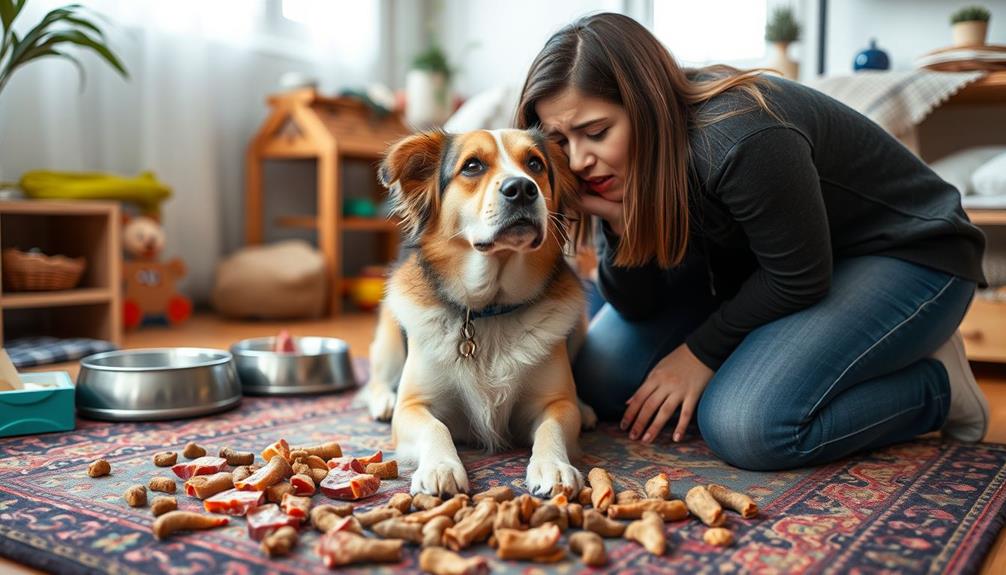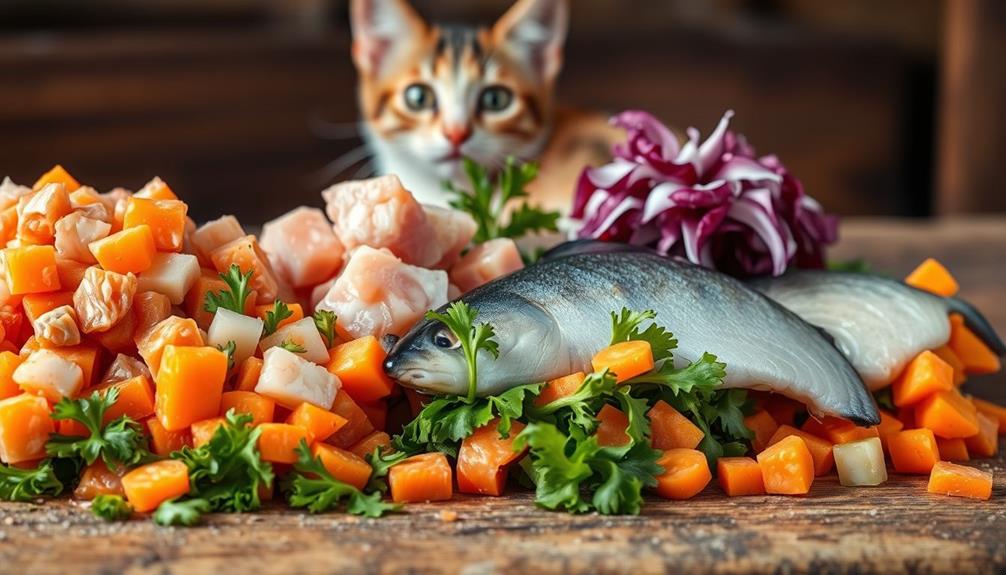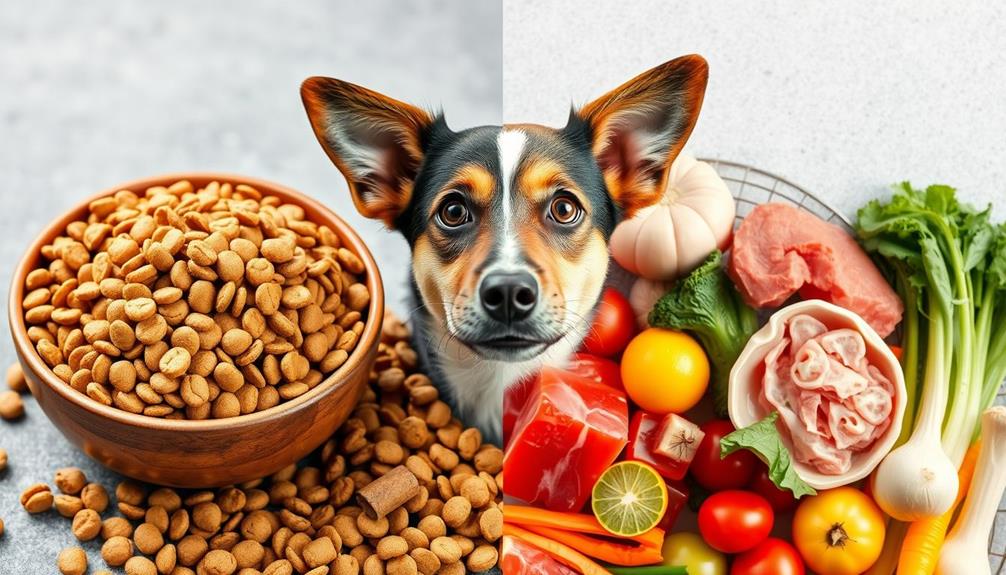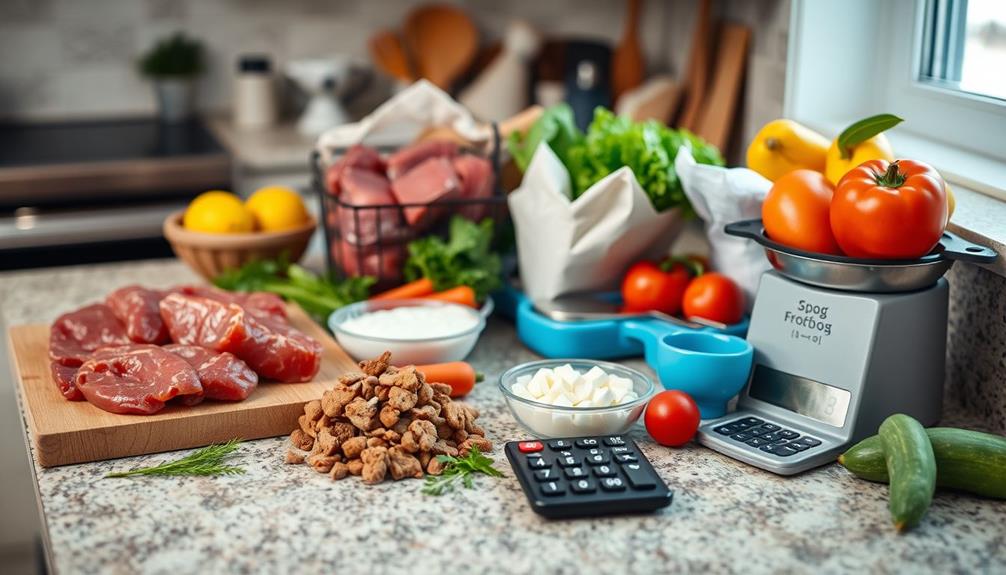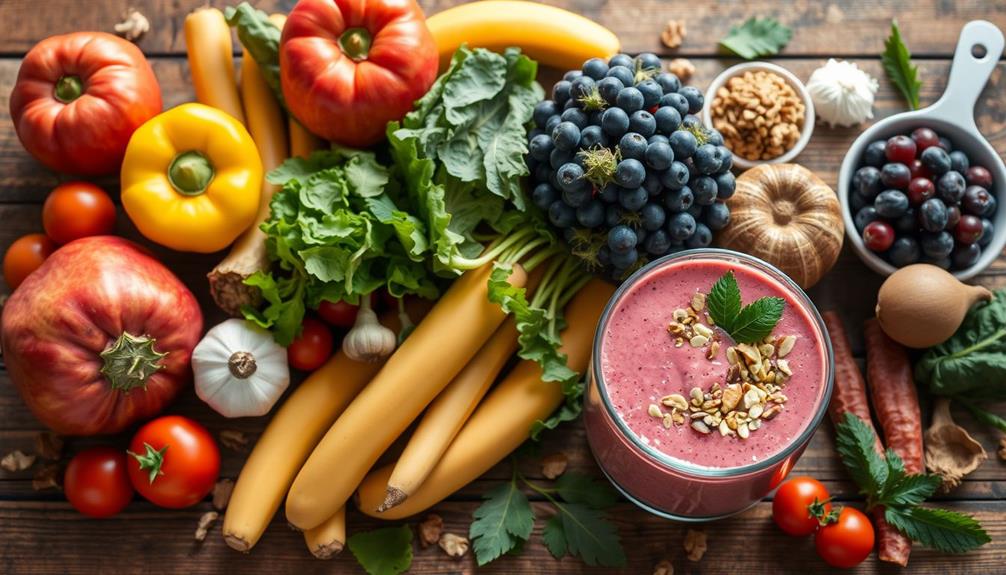If your dog throws up raw food, it could be due to dietary changes, eating too quickly, or the quality of the food. Switching to a raw diet too fast can upset their stomach, while gulping food can cause air swallowing and discomfort. Additionally, make sure the raw food is fresh and handled properly to avoid contamination. Try slowly introducing new foods over 7-10 days and feeding smaller, more frequent meals. If vomiting persists or you notice other concerning signs, consult your vet for further advice and options to make certain your pup stays healthy and happy.
Key Takeaways
- Rapid dietary changes to raw food can upset your dog's digestion, leading to vomiting; introduce new food gradually over 7-10 days.
- Feeding too quickly may cause your dog to swallow air, resulting in gastrointestinal discomfort and vomiting; consider smaller, more frequent meals.
- Monitor for consumption of inappropriate items that could irritate the digestive system; remove any potential hazards from your dog's environment.
- Ensure raw food is handled properly to prevent contamination; improper storage can lead to foodborne illnesses that cause vomiting.
- Persistent vomiting beyond 24 hours or signs of dehydration necessitate immediate veterinary consultation to address potential health issues.
Understanding Vomiting Vs. Regurgitation
When it comes to your dog's health, distinguishing between vomiting and regurgitation is vital. Vomiting originates from the stomach and upper intestines, often producing digested food mixed with stomach acid. In contrast, regurgitation comes from the esophagus, typically presenting as undigested food that resembles its original form.
Understanding this difference is important, as it can have significant health implications for your furry friend. Ensuring your dog has a balanced diet, including healthy dog snacks, can help minimize gastrointestinal issues that lead to vomiting or regurgitation.
When your dog vomits, you might notice signs of distress, like retching or abdominal contractions. This discomfort indicates a more active process that often suggests an underlying issue, such as dietary intolerance, especially if your dog eats raw food.
Regurgitation, on the other hand, is a passive process, requiring little to no effort from your dog and generally causing less distress.
Recognizing whether your dog is vomiting or regurgitating can help you assess its health effectively. If you're uncertain about the symptoms, it's wise to seek veterinary care. Timely intervention can prevent more serious health complications, ensuring your dog stays happy and healthy.
Common Causes of Vomiting
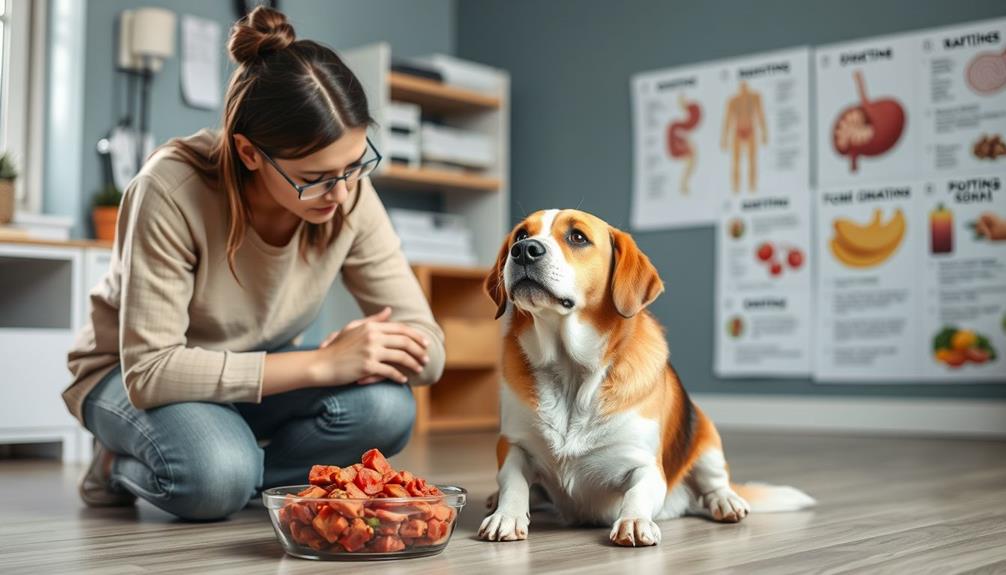
Understanding the differences between vomiting and regurgitation sets the stage for recognizing the common causes of vomiting in dogs. When your dog is on a raw diet, several factors can contribute to vomiting. For instance, a sudden change in diet often leads to digestive upset, similar to how dietary shifts in hamsters can affect their health and well-being.
Here are three common causes:
- Dietary Changes: Shifting from kibble to a raw diet can disrupt your dog's digestive systems, leading to vomiting as they adjust to new pH levels and food types.
- Rapid Eating: If your dog eats too quickly or gets overly excited during mealtime, they may swallow air along with their food. This can cause gastrointestinal discomfort and result in vomiting.
- Inappropriate Items: Sometimes, dogs consume inappropriate items, like slugs or snakes, which irritate their digestive systems. This can trigger vomiting as their bodies try to eliminate the irritants.
Additionally, improper food handling can pose risks to food safety.
Regular cleaning of the cage for pet hamsters can serve as a reminder of the importance of hygiene in food preparation. Contaminated raw food can lead to gastrointestinal issues, including vomiting.
Managing Diet Transitions
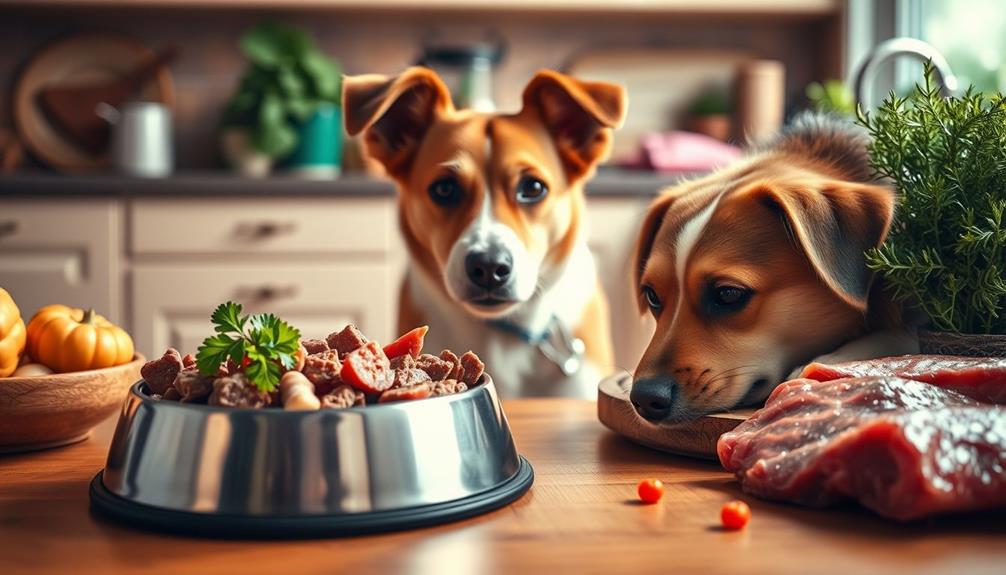
Changing your dog to a raw diet requires careful management to guarantee a smooth adjustment. Start by introducing new food gradually over 7-10 days. This slow change helps minimize the risk of digestive upset and prevents your dog from vomiting.
During this period, feeding smaller, more frequent meals can stabilize digestive health and reduce the chances of hunger pukes. Additionally, confirming that the food is fresh and of high quality can greatly enhance the change process, as professional cleaning services can help maintain a hygienic feeding environment.
It's essential to avoid mixing raw dog food with kibble in the same meal, as their different digestion rates can overwhelm your dog's system, leading to vomiting. Monitor your dog's weight closely and adjust portion sizes to prevent overfeeding, which can also trigger vomiting.
If you're incorporating lower fat options or new foods, consider adding low glycemic carbohydrates like sweet potatoes. These can help buffer the effects of dietary changes and reduce bile acid reflux during the change.
When to Consult a Veterinarian
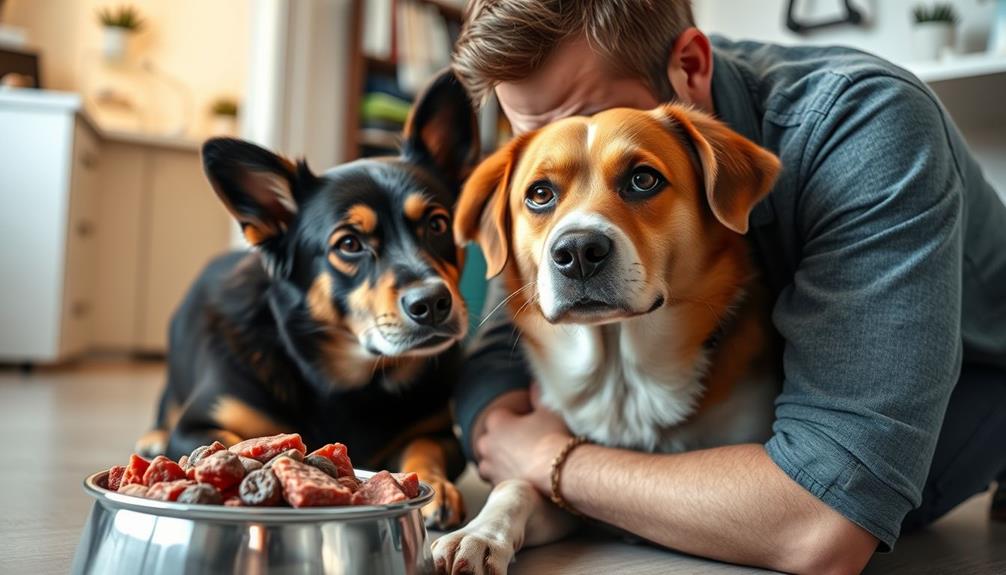
Recognizing the signs that indicate your dog needs veterinary attention is essential for their well-being.
If your dog experiences vomiting, especially when it's persistent or accompanied by other symptoms, it's time to consult a veterinarian. Individuals with certain disorders, such as BPD, may exhibit emotional dysregulation, much like how a dog's health can be affected by dietary changes.
Here are three significant signs you shouldn't ignore:
- Persistent Vomiting: If your dog vomits for more than 24 hours after switching to a raw diet, it's important to seek professional help. This may indicate dietary intolerances or more serious health issues.
- Signs of Dehydration: Look for dry gums or skin that doesn't bounce back when pinched. These signs can be dangerous and require immediate veterinary attention.
- Lethargy or Disorientation: If your dog appears unusually tired or shows signs of disorientation, don't wait. These could be indicators of severe health complications that need prompt assessment.
Cleaning and Safety Tips
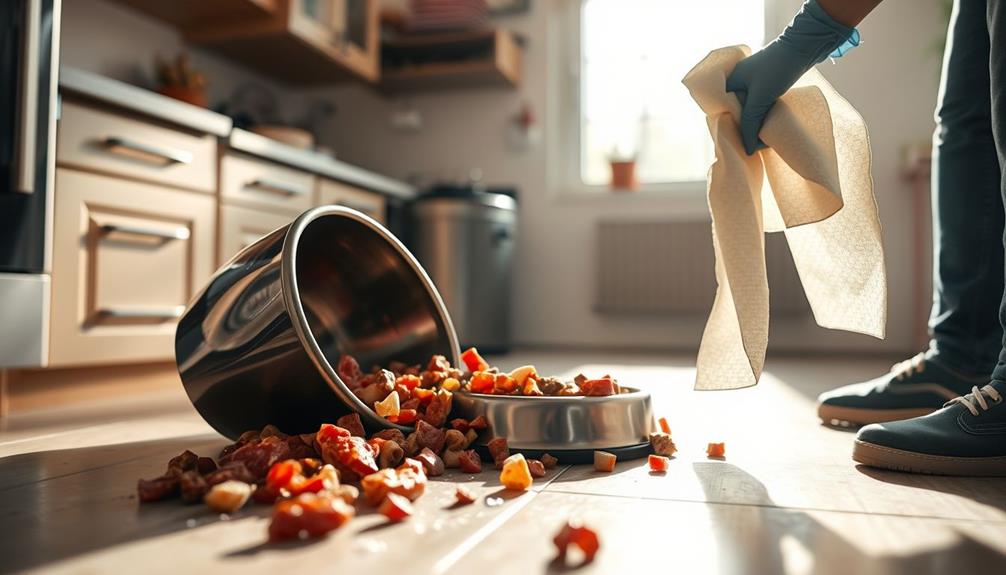
After confirming your dog's health is in check, the next step is managing the aftermath of vomiting. If your dog vomited on hardwood or tile, cleaning is easier compared to carpet. Always clean immediately to prevent lingering odors and stains.
For a quick solution, mix dish soap with hot water to tackle stains effectively. If you encounter tougher marks, a vinegar and cornstarch paste can work wonders. To maintain a healthy environment, consider how waste disposal methods impact your home, similar to the importance of proper disposal habits for toilet maintenance.
To combat any remaining odors, sprinkle baking soda on the affected area. It absorbs both odors and stains, leaving your space fresh-smelling. When choosing cleaning products, always opt for pet-safe options. Check ingredient labels for potential toxins, as some household cleaners can seriously harm your dog.
Proper ventilation is essential while cleaning. Open windows or use fans to guarantee fresh air circulates, especially when using any products.
Prioritize non-toxic alternatives to maintain a safe environment for your furry friend. By following these cleaning and safety tips, you can quickly address the mess while keeping your home safe and comfortable for both you and your dog.
Frequently Asked Questions
Why Is My Dog Throwing up on Raw Food Diet?
If your dog's throwing up on a raw food diet, it could be due to rapid eating, inappropriate items, or sudden dietary changes. Monitor their eating habits and adjust their diet gradually to help alleviate the issue. If your dog continues to experience vomiting on a raw food diet, it might be worth considering transitioning your dog off raw food and onto a different type of diet. Consult with your veterinarian to discuss alternative options and to ensure that your dog is receiving the proper nutrients. They can provide guidance on the best way to transition your dog off raw food without causing any further digestive issues.
Why Is My Dog Throwing up Her Food but Acting Normal?
If your dog's throwing up food but acting normal, it could be due to rapid eating or an empty stomach. Try smaller, more frequent meals and maintain a consistent feeding schedule to reduce this issue.
What to Do if Your Dog Throws up Undigested Food?
If your dog's vomiting undigested food, consider calming consumption. Cut meals into smaller servings to curb quick eating. Keep a close eye on their condition; consult a vet if vomiting persists or worsens.
Can Raw Dog Food Make My Dog Sick?
Yes, raw dog food can make your dog sick. Improper handling, sudden dietary changes, food intolerances, or unbalanced nutrition can all lead to gastrointestinal issues, including vomiting. Always observe your dog's reaction to new food.
Conclusion
To summarize, if your dog throws up raw food, it's crucial to evaluate the cause and manage their diet carefully. Did you know that about 10% of dogs experience vomiting at some point in their lives? Keeping an eye on your pup's eating habits and consulting your vet when needed can make all the difference. With a little attention and care, you can help your furry friend enjoy their meals without any tummy troubles.

